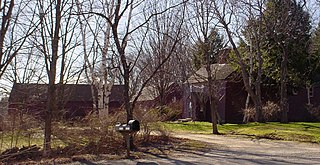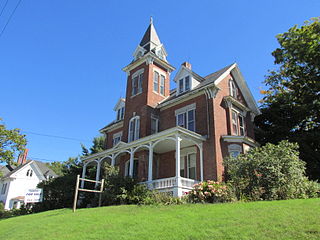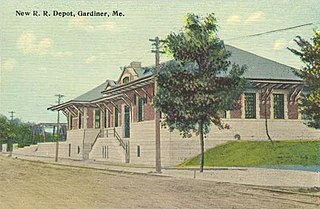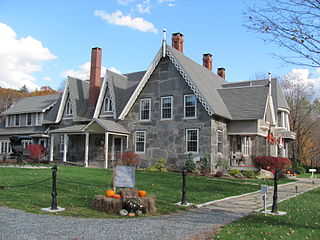Mount Waldo is a small mountain about 1,060 feet (320 m) high in Waldo County, Maine. It is located in the town of Frankfort.

The John Sedgley Homestead is a historic homestead property at Scituate and Chases Pond Road in the York Corner area of York, Maine. Its oldest structure built in the late First Period, probably c. 1715, it is the oldest homestead in the State of Maine that is still in its original setting. Historically the homestead included a cape, farm home, carriage house, stables building, two outbuildings, and a large land holding, all of which is still existing today. The property was listed on the National Register of Historic Places in 1976.

The James C. Lord House is a historic house in Lewiston, Maine. Built in 1885 for a prominent local businessman, it is a high quality blend of late 19th-century architectural styles. It was listed on the National Register of Historic Places in 1978.

Heron Neck Light is a lighthouse on Green's Island in Vinalhaven, Maine at the south end of Penobscot Bay. It was established in 1854 as an aid to navigation for Vinalhaven's main port, and for the Hurricane Channel extending northwest from Heron's Neck. The light was automated in 1984. It was listed on the National Register of Historic Places as Heron Neck Light Station on January 21, 1988.
The former Seal Harbor Congregational Church is a historic church building on Peabody Drive in Seal Harbor, Maine. It was built in 1902, and is an elegant expression of the Shingle style in a seasonal church building. It was listed on the National Register of Historic Places in 1985; it is now vacant.

St. Mark's Episcopal Church was a historic church at 9 Summer Street in Augusta, Maine, just west of downtown. The congregation, founded in 1840, occupied an 1886 Gothic Revival stone building designed by Richard M. Upjohn and listed on the National Register of Historic Places in 1984 for its architecture. The congregation moved out in 2015.
The Union Church of Vinalhaven is a historic church on East Main Street in the center of Vinalhaven, Maine. Built in 1899, it is a high quality example of Shingle style architecture, designed by one of its major promoters, John Calvin Stevens. It was listed on the National Register of Historic Places in 1984.

The Gardiner Railroad Station is a historic former railroad station at 51 Maine Street in Gardiner, Maine. It was built in 1911 by the Maine Central Railroad, and was in use as a station until the 1950s. It has since seen a variety of adaptive commercial uses. A distinctive example of Romanesque architecture, it was added to the National Register of Historic Places on October 29, 1982.
The Pleasant River Grange No. 492 is a historic Grange hall on Round the Island Road in Vinalhaven, Maine. Built as worker housing for a granite quarry, it was moved in 1909 to its present local for use by the local Grange chapter. It continues to be used by that organization as a community resource. It was listed on the National Register of Historic Places in 1999.

The Stone House is an historic house located on Burnham Road in Bridgton, Maine, United States. Built 1828–1830, it is a rare example in Maine of a Cape style house built out of stone in the English masonry style. It was listed on the National Register of Historic Places in 1984.

The Whipple House is a historic house museum at 4 Pleasant Street in Ashland, New Hampshire. Built about 1837, it is a well-preserved example of a mid-19th century Cape-style house, that is relatively architecturally undistinguished. It is significant for its association with George Hoyt Whipple (1878–1976), a Nobel Prize-winning doctor and pathologist who was born here. Whipple gave the house to the town in 1970, and it is now operated by the Ashland Historical Society as a museum, open during the warmer months. The house was listed on the National Register of Historic Places in 1978.

The Stone-Darracott House is a historic house on Old Marlborough Road in Dublin, New Hampshire. It was built in 1792 by John Stone, an early settler of Dublin for whom nearby Stone Pond is named. The house was also made part of a "gentleman's farm" by Mrs. Alberta Houghton in the early 20th century, along with the adjacent Stone Farm. The house was listed on the National Register of Historic Places in 1983.

The Durham House is a historic house on Ball Park Road in Goshen, New Hampshire. Built about 1860, it is one of a cluster of plank-frame houses built in the rural community in the 19th century. This one is further note for its Greek Revival features, and its construction is tentatively ascribed to James Chandler, a noted local builder. The house was listed on the National Register of Historic Places in 1985.
The Lawrence Library is the public library of Fairfield, Maine. It is located at 33 Lawrence Avenue, in an architecturally distinguished Romanesque Revival building designed by William R. Miller and completed in 1901. The building was listed on the National Register of Historic Places in 1974.

Stone Barn Farm is one of a small number of surviving farm properties on Mount Desert Island off the coast of Maine. Located at the junction of Crooked Road and Norway Drive, the farm has a distinctive stone barn, built in 1907, along with a c. 1850 Greek Revival farm house and carriage barn. The property was listed on the National Register of Historic Places in 2001, and is subject to a conservation easement held by the Maine Coast Heritage Trust.

The Theodore Jellison House, also known locally as the Stone House, is a historic house on River Road in eastern Calais, Maine. Built in 1825, it is one of the oldest surviving residences in the town, and an impressive local example of granite construction. Theodore Jellison, its builder, was a local owner of granite quarries. The house was listed on the National Register of Historic Places in 1984.
The Murch Family House is a historic house on Calderwood Neck in Vinalhaven, Maine. Built in 1855, it is the only granite house in a community long known for its granite quarries, and one of a relatively small number of documented stone houses in the state. It was listed on the National Register of Historic Places in 1993.

The Percy District School House is a former district school at the junction of Parker Head and Cox Head Roads in Phippsburg, Maine. Now adapted for use as a private residence, this 1830s school house is one of a small number of 19th-century district schools in the state to be built out of granite blocks. It was listed on the National Register of Historic Places in 1999.

Glimmerstone is a historic mansion house on Vermont Route 131, west of the village center of Cavendish, Vermont. Built 1844–47, it is a distinctive example of Gothic Revival architecture, built using a regional construction style called "snecked ashlar" out of locally quarried stone flecked with mica. The house was listed on the National Register of Historic Places in 1978.

The Moses Webster House is a historic house at 14 Atlantic Avenue in Vinalhaven, Maine. It was built in 1873 for Moses Webster, owner of one of Vinalhaven's granite quarries, and is one of the community's finest examples of Second Empire architecture. It was listed on the National Register of Historic Places in 1998.
















